Ijraset Journal For Research in Applied Science and Engineering Technology
- Home / Ijraset
- On This Page
- Abstract
- Introduction
- Conclusion
- References
- Copyright
Planning, Scheduling and Allocation of Resources for Huge Structures using Oracles Primavera P6 software
Authors: Rahul Wagh, Pranav Lende
DOI Link: https://doi.org/10.22214/ijraset.2022.44627
Certificate: View Certificate
Abstract
Proper planning and scheduling is very important part of construction projects for reducing and controlling delays of the project. Substantial amounts of time, money and resources are wasted each year in a construction industry due to improper management of construction activities. Oracle’s Primavera P6 is the globally accessible and world’s fastest, powerful, user friendly, easy to use robust and software application which is used to manage projects, programs and portfolios. Prioritizing, Managing, Scheduling, Planning can be done in favor of the globally located projects. It provides single solution to manage alter and update the project of any scale. Risk is present everywhere, every area of life. In construction industry risk is always present. The purpose of current work is to study of various risks in construction projects, their importance and impact on the project goals, time schedule and plan for the risk analysis.
Introduction
I. INTRODUCTION
Risk management is an idea which is been utilized in every industries, it might be IT related enormous business, pharmaceutical business or automobile industry to the construction division. For each organization there will be fixed fundamentals set for risk tackling as per which they work. This shows a solid connection between project success and managing risk. Risk management can be quickly characterized as a field of hierarchical goings-on and professional practice. Risk management is taken as one of the toughest part of the construction process and its application must be empowered in every one of the project to avoid negative results in the project. In the era of progressive globalization it is hard to avoid risk, which has become an indispensable part of everyday life. Effective risk management does not mean the removal of risk, which would be the seemingly be the cheapest option. From economic point of view this is pointless because what is potentially profitable is by definition risky and activity that does not pose a risk economically interesting.
II. LITERATURE REVIEW
Vishal Annappa Nimbal et.al (2017)the computer based Project Management software/tool Primavera P6 for the Planning, Scheduling and Allocation of resources for a (G+8) residential apartment building.
It helps to know the resemblance between the planned the planned progress of construction work and actual progress of the performed work. Thus the essentiality and the advantages of using Primavera will be outlined through the data results obtained. The acceptance of the software Primavera as a platform of scheduling is been on a boom in Multi National Construction Companies, but due to ignorance and lack of Project Management concepts and discourage towards the use of computer based programs, small and medium scale Indian construction companies confront various issues such as inefficient planning, project delays, inefficiency of resources and many other issues. Therefore, they also attempted to educate one such medium scale construction company about the advantages of Primavera in execution of any construction projects efficiently. The main goal and the mission of this study was to know the role of planning, Scheduling, Monitoring and Control of the project progress with timely accomplishment of any construction project. This terminus was accomplished with the aid of literature references and the unique methodologies interlaced in Monitoring and Control with the help of Primavera project management software. The output results of the current case study defies the vitality of efficient planning, Scheduling, Monitoring and Controlling. Along with that the essential need and the influence of the project management software like Primavera P6 in any type of medium to large scaled Construction Projects.
The estimated completion time for the same project was earlier was framed to 640 days by the contractor, which is almost equals to 21.5 months. But the same project with precise and punctual planning, controlling, implementation and monitoring of the every activity using Primavera tool the expected time of the project completion is being planned to 434 days. The in charge Project Manager should be well aware about the schedule with respect to the activities, which are to be started or finished according to the schedule.
- For the current project the planned schedule activities are productive
- The implementation of immense monitoring policies could be well observed.
- On the various tasks of schedule completion the very high and systematic priority is been provided.
- The usages of various resources throughout the project run would be optimum.
- The software Primavera P6 proved like a perfect and efficient tool for the purpose of monitoring and controlling of the various construction project. The time for updating effort will be highly decreased by the specific layout.
Jmeelahammad Nadaf et.al (2018) studied the methods to classify project risks, that have been particularized for construction projects, have been presented from various point of view(from contractors, consultants, and government contractors) and construction companies and firms that may be helping the development of dealing with project in the planning and construction stages. Matrix for probability-impact, impact-urgency, probability urgency and priority-urgency plotted and high risks were marked. A brief mitigation plans for avoiding and resolving of the risks were prepared. The methods to classify project risks, that have been particularized for construction projects, have been presented from various point of view(from contractors, consultants, and government contractors) and construction companies and firms that may be helping the development of dealing with project in the planning and construction stages. Matrix for probability-impact, impact-urgency, probability-urgency and priority-urgency plotted and high risks were marked. A brief mitigation plans for avoiding and resolving of the risks are prepared. The project has studied various factors related to risks and some of outcomes are listed below:
a. The risks management process starts prior to project itself.
b. Record of all the risk occurred and occurring, occurs in future should be maintained.
c. Every organization big or small should be adopt risk management practices to reduce effect of risks arising in the project and its impact to reach the project goals.
d. There must be proper coordination between every distinct involved with project to implement better risk management practices.
e. Every organization big or small should be adopt risk management practices to reduce effect of risks arising in the project and its impact to reach the project goals.
f. Clear understanding of the project scope explaining of the complete outcome of project.
g. From the results, it is safe to say that majority of the construction projects have no systematic procedure in place to deal with risks. Risk management is done in a very informal mode.
h. All the risks were recorded and ratings were given for their probability of occurrence, its impact on the project and urgency of resolving particular risk.
Shah Harsh et.al (2017) studied Project Monitoring acts like a warning mechanism; it is the process of recording, collecting and reporting information regarding project performance that the project manager and others wish to know. Monitoring includes watching the progress of the project against time, performance schedule and resources during actual execution of the project and it identified the lagging areas which require timely attention and actions. Large projects become more complex and the ability to exchange information on paper within the organization on a timely basis gets difficult. The traditional project management system cannot meet the demands of today’s projects, as a tremendous amount of information and data on a project is always changing. The main objectives of this study are to plan, schedule, and track an industrial project with the help of primavera software, also to recommend measures to the organization for enhancing their project planning for similar projects in future.
From this literature we can conclude the following things:
- Planning, scheduling and tracking of any construction project can be done efficiently using Primavera P6 software.
- Management of multiple projects can be carried out efficiently using Primavera P6 software.
- The Primavera P6 software is very useful in resource smoothing and resource leveling operations.
- Project management using Primavera P6 software is more efficient, less time consuming and it requires less paperwork than conventional method.
- The Primavera software provides detail information about cost control, time management, working hour management, update and monitoring and delay of activities which enhance effectiveness in delivering services.
- The Primavera software tracks the project in a better manner. With the use of earned value performance indices such as Schedule Performance Index (SPI) and Cost Performance Index (CPI) project progress can be tracked in a better manner.
- The Primavera software helps in finding out critical activities of the project so that special concern can be given to those activities and delay in the project can be avoided.
- About 5% reduction in the cost of labor can be achieved using Primavera software.
III. SYSTEM DEVELOPMENT AND ANALYSIS
Generally Primavera P6 do works on the methodology of dynamic scheduling. This indeed provides the Project Management office with a clear route map, which is intended to establish the best possible optimized plan of the project by using ‘what-if’ scenarios risk extenuation methods. Despite, the fact that it exhibit the Project Manager’s capability to produce management change possibilities for the Project Management team to select from the when variances by the proposed project Baseline are being noticed. The method of dynamic scheduling frames the base or the platforms for the project scheduling which is designed to support the team of Project Management with certain official philosophies, policy, guidelines, terminology, templates and procedures which could include the coaching and training tool or platform through which a particular timeline of events, steps, and the project milestones are accomplished. Dynamic scheduling methodology is based on the below mentioned some indirect activities which are executed by the various Project Management team and its stakeholders.
- Work/Budget Scope – Project Management Team/office
- Strategic Planning -- Project Management Team/office
- Project Work Breakdown Structure – Scheduler of the project
- Focused of the geographical and the physical breakdown of the past completed.
In this dissertation work analysis of a “Water Treatment Plant’, situated in Pune area is done which was under the EPS of mining and Metals of Ultramake Group. The project was carried out from 2nd of April 2019 and following is the information available.
Calendar: 6 working days, Sunday is non- working day; Working time 9 am to 1pm and 2pm to 6p
Holidays: May 01, August 15, January 26, October 02, December 25.
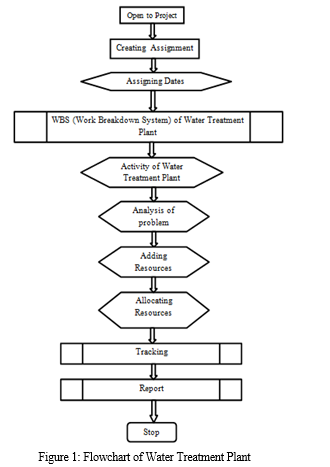
A. Creating Assignment
Creating assignment means to create a new module in manager file. Figure 2 shows new assignment created.
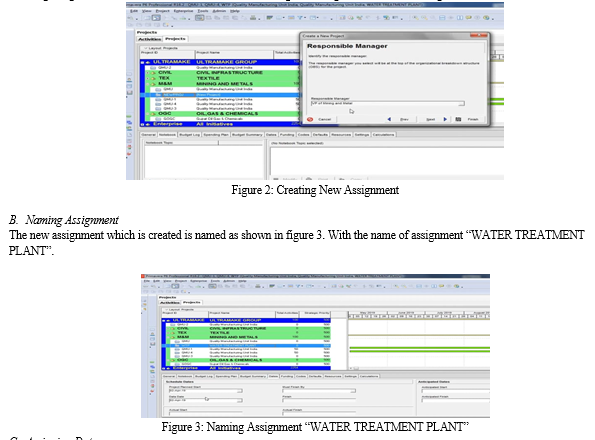
???????C. Assigning Dates
The dates selected for project are such that which has less delay and bugs. Project calendars are the significant part of the project schedules. The project calendars exhibit the working days, exceptions, suspensions, non-working days, holidays any other days corresponding to that project when used it properly. Even though, the calendars are categorized depending upon the need, the type of organizations, country/state/region of the proposed project and other parameters. Figure 4 shows calendar arrangement.
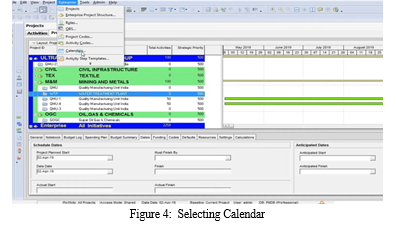
???????D. WBS (Work Breakdown System) of Water Treatment Plant
The term Work Breakdown Structure is in short commonly called as WBS. It is a process of grouping different elements of the project with concerned to specific product and it organizes or impinges to define the overall intent of the project. All the main activities which are to be done are listed in step. Further there are also more sub states of the WBS.
The WBS of Water Treatment Plant is shown in table 1.
The WBS window looks as shown in figure 5.
Table No: 3.1: WBS of Water Treatment Plant
|
WBS CODE |
WBS NAME |
|
PLS |
Planning And Survey |
|
WTP |
Design of WTP Unit |
|
PPAPF |
Proposal Preparation And APF |
|
TDOC |
Tendering And Documentation |
|
WOS |
Work On Site |
|
DG |
Drainage Gallery |
|
IW |
Intake Well |
|
APL |
All Pipe Lines |
|
FU |
Filtration Unit |
|
ESR |
Constant ESR |
|
GSR |
Constant of GSR |
|
PRBW |
Pump Room, Boundary Wall |
|
CEL |
Complete Electrical Layout |
|
HOS |
Handling Over Site |
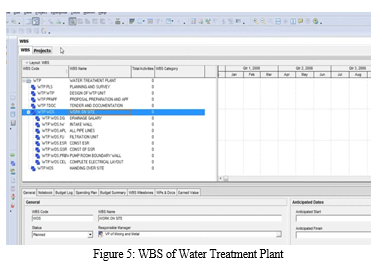
An activity is an element of every project and its schedule, the number of such various activities together forms a complete Project or its Schedule. The activity can be considered as the task or an event which contributes to accomplish the undertaken project. Every particular activity has its specific descriptions about activity duration, start date, finish date and one or multiple logic relationships/ties. The duration needed for each activity is added is also added in this step with the initial start date as the same as start date of the project.
Figure 6 show the window of WBS and Activities Layout of the Project.
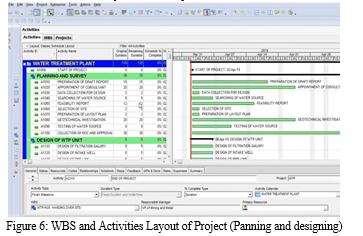
???????E. Adding Resources
All the resources needed for performing the activity such as Labour, Material are added to worksheet along with their rates. The resources been used in the Water Treatment Plant is shown in table 2. The resources are taken from the software itself or imported from excel.
Table 2: Resources used for Water Treatment Plant
|
Resource ID |
Resource Name |
Resource Type |
Unit of Measure |
Max. Unit/Time |
Price/Unit |
|
PE |
Planning Engineer |
Labour |
- |
1 |
1500/d |
|
CE |
Consultant Engineer |
Labour |
- |
1 |
1400/d |
|
SE |
Structural Engineer |
Labour |
- |
2 |
1800/d |
|
UW |
Unskilled Worker |
Labour |
- |
20 |
300/d |
|
SW |
Skilled Worker |
Labour |
- |
10 |
450/d |
|
RCC |
Reinforced Cement Concrete |
Material |
Cubic-mtr |
- |
5800/cum |
|
BW |
Brick Work |
Material |
Cubic-mtr |
- |
3500/cum |
|
PT |
Painting |
Material |
square-mtr |
- |
6000/sqm |
|
SST |
Structural Steel |
Material |
Kilogram |
- |
6500/kg |
|
EXV |
Excavation |
Non- Labour |
- |
1 |
1200/hr |
|
HD150 |
HDPE 150 mm |
Material |
Running-mtr |
- |
16500/rm |
|
GI |
GI 150 mm |
Material |
Running-mtr |
- |
12500/rm |
|
SV150 |
Stop Valve 150 mm |
Material |
Numbers |
- |
2500/no |
|
PUMP01 |
Pump 01 HP |
Material |
Numbers |
- |
2500/no |
Figure 7 show the window regarding adding resources to module.
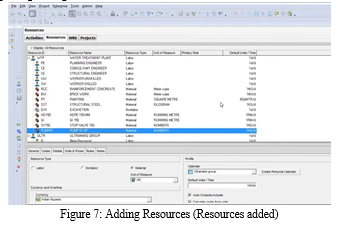
The project resources are to be leveled once the resources are allocated to the activity to increase the work efficiency and thereby minimizing the cost. Resource leveling is the process of flattering the daily resource requirement by altering the time at which a particular activity is encountered without affecting the logic. In order to do so, resource constraints are used.
Figure 8 and figure 9 show allocating resources to activities.
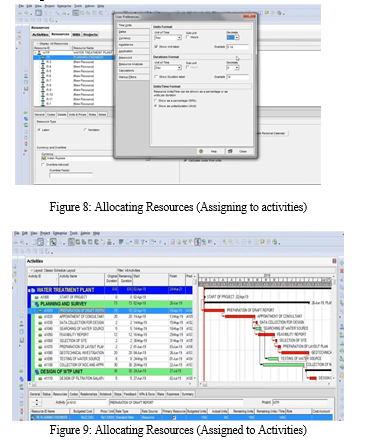
???????F. Assigning Responsibility And Measuring Project Progress
Activities consume time and resources therefore, their assigning and measurement are to be done precisely. Assigning activities to liable parties is dominant as it considerably helps in breaking the project into controllable pieces, assigning them to the parties that are efficient to complete the task. In addition to defining the activity behaviour, the assignment expresses the responsible party. In order to control the activity of the project, the progress of each activity must be evaluated and the one responsible for its satisfactory progress must be held. Generally, activities are measured by the resources allocated, percentage complete. Progress must be measured depending on resources used rather than planned; this is found to be the most effective method even though it requires tracking of the resources every 70 days.
Table 3 shows the track of project.
Figure 10 shows the window for assigning responsibilities and measuring project progress.
Table 3: Tracking Project
|
Activity ID |
Actual Start |
Actual Finish |
Actual Units |
Actual Complete |
|
A1000 |
02APR19 |
- |
0 |
- |
|
A1010 |
02APR19 |
20APR19 |
19 |
100% |
|
A1020 |
21APR19 |
19MAY19 |
23 |
100% |
|
A1030 |
20MAY19 |
21MAY19 |
- |
100% |
|
A1040 |
22MAY19 |
26MAY19 |
- |
100% |
|
A1050 |
22MAY19 |
02JUNE19 |
18 |
100% |
|
A1060 |
03JUNE19 |
04JUNE19 |
- |
100% |
|
A1070 |
05JUNE19 |
06JUNE19 |
- |
100% |
|
A1080 |
07JUNE19 |
- |
- |
10%(PHY) |
|
A1090 |
04JUNE19 |
- |
- |
60%(PHY) |
|
A1100 |
20MAY19 |
- |
- |
30%(DUR) |
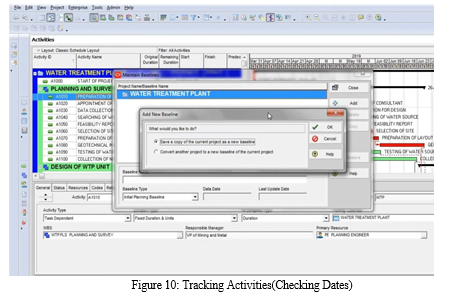
???????G. Report Preparation
Report preparation is an important step in working with Primavera P6 software. It is essential to have report copies to keep track of off-field and on-field schedule and to also know the flow of work going. At the interval of every 60-70 days; depending upon the size and criticality of construction work; reports are taken to keep track of work and to work accordingly. At these intervals the module is updated depending upon the work completed on field. As there may be certain unavoidable circumstances on field which we were unaware of at the start of work module there is always difference of on and off filed work so report making and tracking of activities are essential steps in working with Primavera P6 software.
Figure11 shows few pictures of reports.
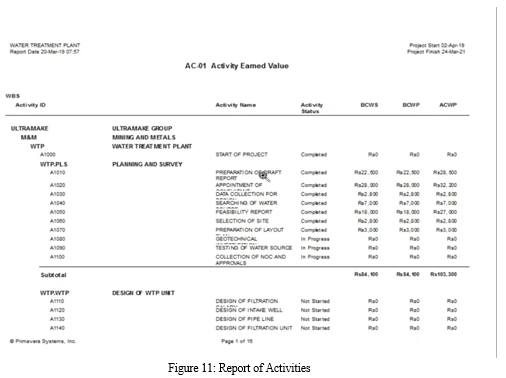 ???????
???????
Conclusion
Following are the conclusions drawn from above work: 1) The main goal and the mission of this study was to know the role of planning, Scheduling, Monitoring and Control of the project progress with timely accomplishment of any construction project. 2) Planning, scheduling and tracking of any construction project can be done efficiently using Primavera P6 software. 3) Management of multiple projects can be carried out efficiently using Primavera P6 software. 4) The Primavera P6 software is very useful in resource smoothing and resource leveling operations. 5) The Primavera software provides detail information about cost control, time management, working hour management, update and monitoring and delay of activities which enhance effectiveness in delivering services.
References
[1] Vishal Annappa Nimbal1, Prof. Balasaheb Jamadar2 (2017) “Planning, Scheduling and Allocation of Resources for Multi-Storied Structure using Oracle’s Primavera P6 software”, International Research Journal of Engineering and Technology (IRJET) e-ISSN: 2395-0056 Volume: 04 Issue: 07 | July -2017 www.irjet.net p-ISSN: 2395-0072 . [2] Jameelahammad Nadaf1, Mahaboobali Nadaf2, Balasaheb Jamadar3, K. P. Thejaswi4 (2018), “Qualitative Risk Analysis for Construction Projects”, International Research Journal of Engineering and Technology (IRJET) e-ISSN: 2395-0056 Volume: 05 Issue: 06 | June-2018 www.irjet.net p-ISSN: 2395-0072. [3] 1Shah Harsh, 2Prof Mamta Rajgor, 3Dr Jayeshkumar Pitroda (2017) , “A Critical Literature Review on Implementation of Primavera Software on Construction Project”, © 2017 IJCRT | Volume 5, Issue 4 November 2017 | ISSN: 2320-2882. [4] Amin Rezaian (2011), “Time-Cost-Quality-Risk of Construction and Development Projects or Investment”, Middle-East Journal of Scientific Research 10 (2): 218-223, 2011 ISSN 1990-9233. [5] Lou Yongli (2016), “ Study on Bidding Evaluation Method and Bidding Strategy of Construction Project “, Advanced Research and Technology in Industry Applications (WARTIA 2016) The Fifth electronics research institute of ministry of industry and information technology, Guangzhou, Guangdong 510610, Tianhe District, Dongguan, Road No. 110. [6] Rajan R. Yadav1, Prof. A. N. Bhavsar2, Dr. J. R. Pitroda3 (2021), “Effective Scheduling and Control of 4M by Applying OR Techniques and Advance Technology at RMC Plant: A Review”, International Journal for Research in Applied Science & Engineering Technology (IJRASET) ISSN: 2321-9653; IC Value: 45.98; SJ Impact Factor: 7.429 Volume 9 Issue III Mar 2021- Available at www.ijraset.com [7] Pawel szymanski (2017), “Risk management in construction projects” , EURO working group Operational Research in Sustainable Development and Civil Engineering 24 May- 2nd International Workshop on flexibility in sustainable construction, ORSDCE 2017, 24-26 April, PP 174-182. [8] Akash Rajkumar Wadhwa and Dattatray Santram Shinde (2016), “Project Management Using Primavera P6 8.2”, International Journal of Innovative Research in Science, Engineering and Technology, Vol. 3, Issue 11, Nov-2016. [9] Abbas M Abd and Suhad M Abd (2012), “Resources Sustainability Planning Model Using Hierarchical Approach for Construction Project”, Diyala Journal of Engineering Sciences, Vol. 05, No. 02, pp. 1-19, Dec-2012.
Copyright
Copyright © 2022 Rahul Wagh, Pranav Lende. This is an open access article distributed under the Creative Commons Attribution License, which permits unrestricted use, distribution, and reproduction in any medium, provided the original work is properly cited.

Download Paper
Paper Id : IJRASET44627
Publish Date : 2022-06-20
ISSN : 2321-9653
Publisher Name : IJRASET
DOI Link : Click Here
 Submit Paper Online
Submit Paper Online

